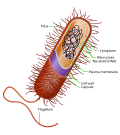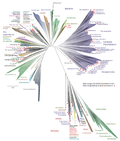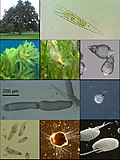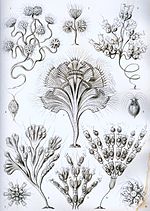The eukaryotes (/juːˈkærioʊts, -əts/ yoo-KARR-ee-ohts, -əts) constitute the domain of Eukarya or Eukaryota, organisms whose cells have a membrane-bound...
61 KB (6,130 words) - 18:03, 20 September 2024
Prokaryote (section Relationship to eukaryotes)
nuclei are placed in a third domain, Eukaryota. Prokaryotes evolved before eukaryotes, and lack nuclei, mitochondria or most of the other distinct organelles...
44 KB (4,770 words) - 00:41, 21 September 2024
Eukaryogenesis (redirect from Crown eukaryotes)
eukaryotic cell and lineage, is a milestone in the evolution of life, since eukaryotes include all complex cells and almost all multicellular organisms. The...
19 KB (1,957 words) - 15:07, 20 June 2024
Amorphea (category Eukaryote unranked clades)
or to Malawimonada or being a paraphyletic group external to all other eukaryotes. The unikonts have a triple-gene fusion that is lacking in the bikonts...
9 KB (1,160 words) - 16:46, 18 June 2024
cells do have a distinct nucleus (eukaryotes). In 1937 Édouard Chatton introduced the terms "prokaryote" and "eukaryote" to differentiate these organisms...
74 KB (4,819 words) - 10:13, 22 July 2024
archaea that contain eukaryotic signature proteins. It appears that the eukaryotes, the domain that contains the animals, plants, and fungi, emerged within...
33 KB (2,842 words) - 17:39, 29 July 2024
This list of "sequenced" eukaryotic genomes contains all the eukaryotes known to have publicly available complete nuclear and organelle genome sequences...
27 KB (1,330 words) - 19:08, 18 August 2024
Microorganism (section Eukaryotes)
adult form are eukaryotes, including humans. However, many eukaryotes are also microorganisms. Unlike bacteria and archaea, eukaryotes contain organelles...
74 KB (7,754 words) - 01:47, 13 September 2024
Plants are the eukaryotes that form the kingdom Plantae; they are predominantly photosynthetic. This means that they obtain their energy from sunlight...
95 KB (8,057 words) - 06:07, 5 September 2024
Eukaryote hybrid genomes result from interspecific hybridization, where closely related species mate and produce offspring with admixed genomes. The advent...
110 KB (11,196 words) - 05:23, 20 May 2024
Protist (category Obsolete eukaryote taxa)
including extreme habitats. Their diversity, larger than for all other eukaryotes, has only been discovered in recent decades through the study of environmental...
94 KB (9,770 words) - 08:12, 30 August 2024
and other membrane-bound organelles are included in Eukarya and called eukaryotes. Non-cellular life, most notably the viruses, is not included in this...
12 KB (1,293 words) - 00:44, 25 July 2024
region. Prokaryotes are single-celled organisms such as bacteria, whereas eukaryotes can be either single-celled, such as amoebae, or multicellular, such as...
60 KB (6,271 words) - 04:42, 20 August 2024
posterior' and κοντός (kontós) 'pole, i.e. flagellum') are a broad group of eukaryotes, including both the animal and fungus kingdoms. The opisthokonts, previously...
20 KB (1,419 words) - 03:26, 19 August 2024
Biology (section Eukaryotes)
chromosomes in eukaryotes, and circular chromosomes in prokaryotes. The set of chromosomes in a cell is collectively known as its genome. In eukaryotes, DNA is...
133 KB (13,817 words) - 07:02, 19 September 2024
Symbiogenesis (category Eukaryote genetics)
proto-eukaryote engulfed a protomitochondrion, and this endosymbiont became an organelle, a major step in eukaryogenesis, the creation of the eukaryotes. Mitochondria...
70 KB (7,517 words) - 19:12, 17 July 2024
Susan C.; Brown, Matthew W.; Roger, Andrew J. (2014). "On the Age of Eukaryotes: Evaluating Evidence from Fossils and Molecular Clocks". Cold Spring Harbor...
7 KB (527 words) - 17:08, 12 September 2024
which evidence suggests to be the evolutionary root of eukaryotes, thereby making eukaryotes members of the domain Archaea. While the features of Asgard...
42 KB (4,600 words) - 05:53, 13 September 2024
D, Bowser SS, et al. (September 2012). "The revised classification of eukaryotes". The Journal of Eukaryotic Microbiology. 59 (5): 429–493. doi:10.1111/j...
8 KB (739 words) - 15:58, 3 September 2024
well as several other clades comprising some 300 species of unicellular eukaryotes. Amoebozoa and Opisthokonta are sometimes grouped together in a high-level...
45 KB (4,016 words) - 03:28, 14 September 2024
Transcription (biology) (redirect from MRNA biosynthesis (eukaryotes))
characteristic elongation rates in prokaryotes and eukaryotes are about 10–100 nts/sec. In eukaryotes, however, nucleosomes act as major barriers to transcribing...
58 KB (6,787 words) - 20:17, 9 August 2024
Excavata (section Origin of the Eukaryotes)
phylogenomic analyses, the group was shown to contain three widely separated eukaryote groups, the discobids, metamonads, and malawimonads. A current view of...
20 KB (1,637 words) - 15:47, 3 September 2024
Archaea (section Relation to eukaryotes)
several metabolic pathways that are more closely related to those of eukaryotes, notably for the enzymes involved in transcription and translation. Other...
156 KB (16,498 words) - 04:39, 18 September 2024
considered universal to eukaryotes. The several plastids including chloroplasts are distributed among some but not all eukaryotes. There are also occasional...
28 KB (2,365 words) - 16:48, 9 September 2024
SAR or Harosa is a highly diverse clade of eukaryotes, often considered a supergroup, that includes stramenopiles (heterokonts), alveolates, and rhizarians...
11 KB (1,083 words) - 02:19, 13 September 2024
two main theories exist. Firstly, Giardia may be extremely primitive eukaryotes that branched off early from other members of their group. This theory...
15 KB (1,577 words) - 17:44, 21 July 2024
Protein biosynthesis (redirect from Protein biosynthesis (eukaryotes))
Protein synthesis is a very similar process for both prokaryotes and eukaryotes but there are some distinct differences. Protein synthesis can be divided...
40 KB (4,342 words) - 18:58, 2 April 2024
construction (or level of organization) characteristic of many prokaryotes and eukaryotes and their means of motion. The term presently does not imply any specific...
13 KB (1,350 words) - 03:43, 17 June 2024
share a highly conserved catalytic center. However, the ribosomes of eukaryotes (animals, plants, fungi, and large number unicellular organisms all with...
40 KB (3,977 words) - 01:19, 21 April 2024
Ribosome biogenesis (section Eukaryotes)
the cytoplasm with the transcription of many ribosome gene operons. In eukaryotes, it takes place both in the cytoplasm and in the nucleolus. It involves...
17 KB (2,271 words) - 01:56, 3 December 2023



























